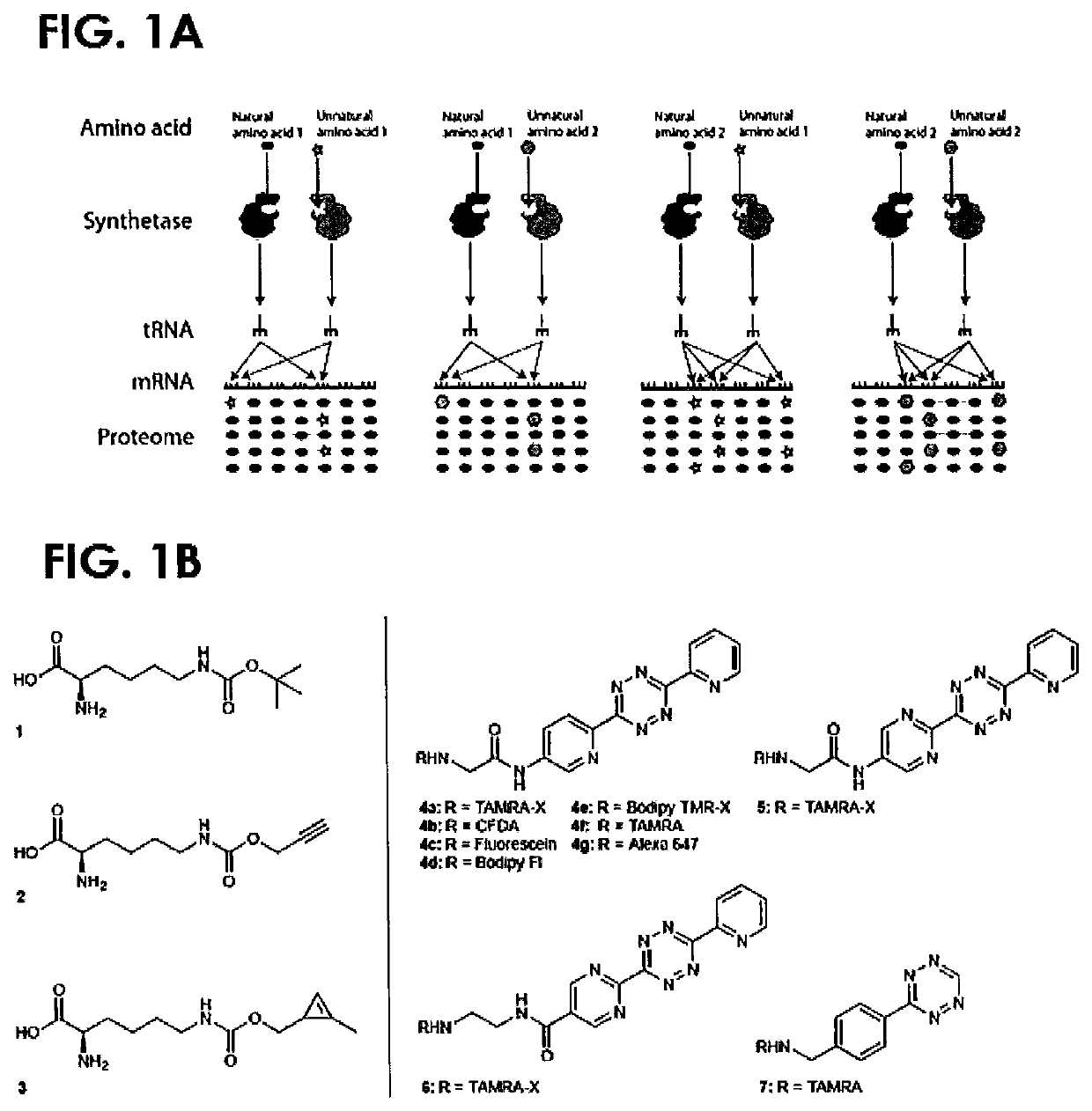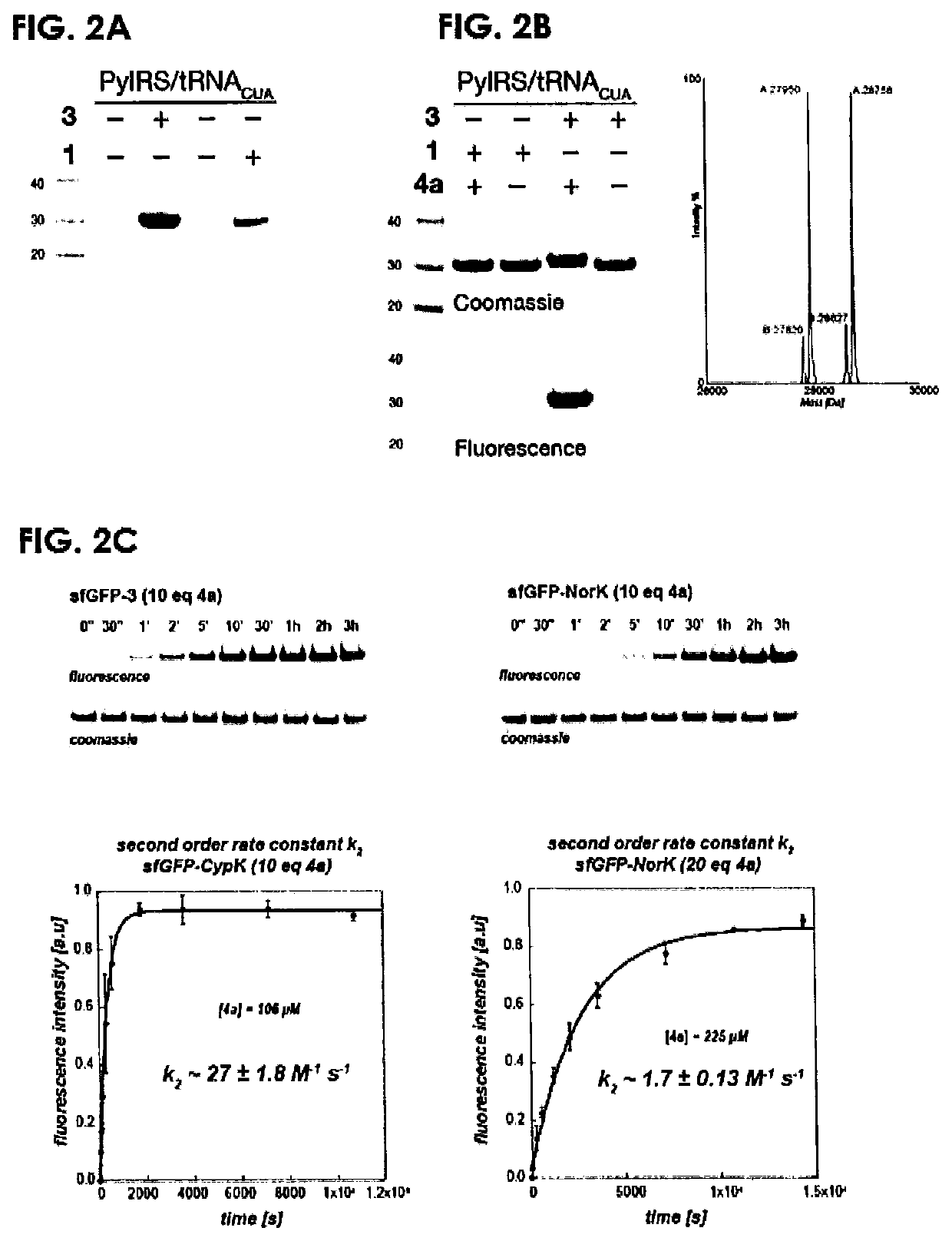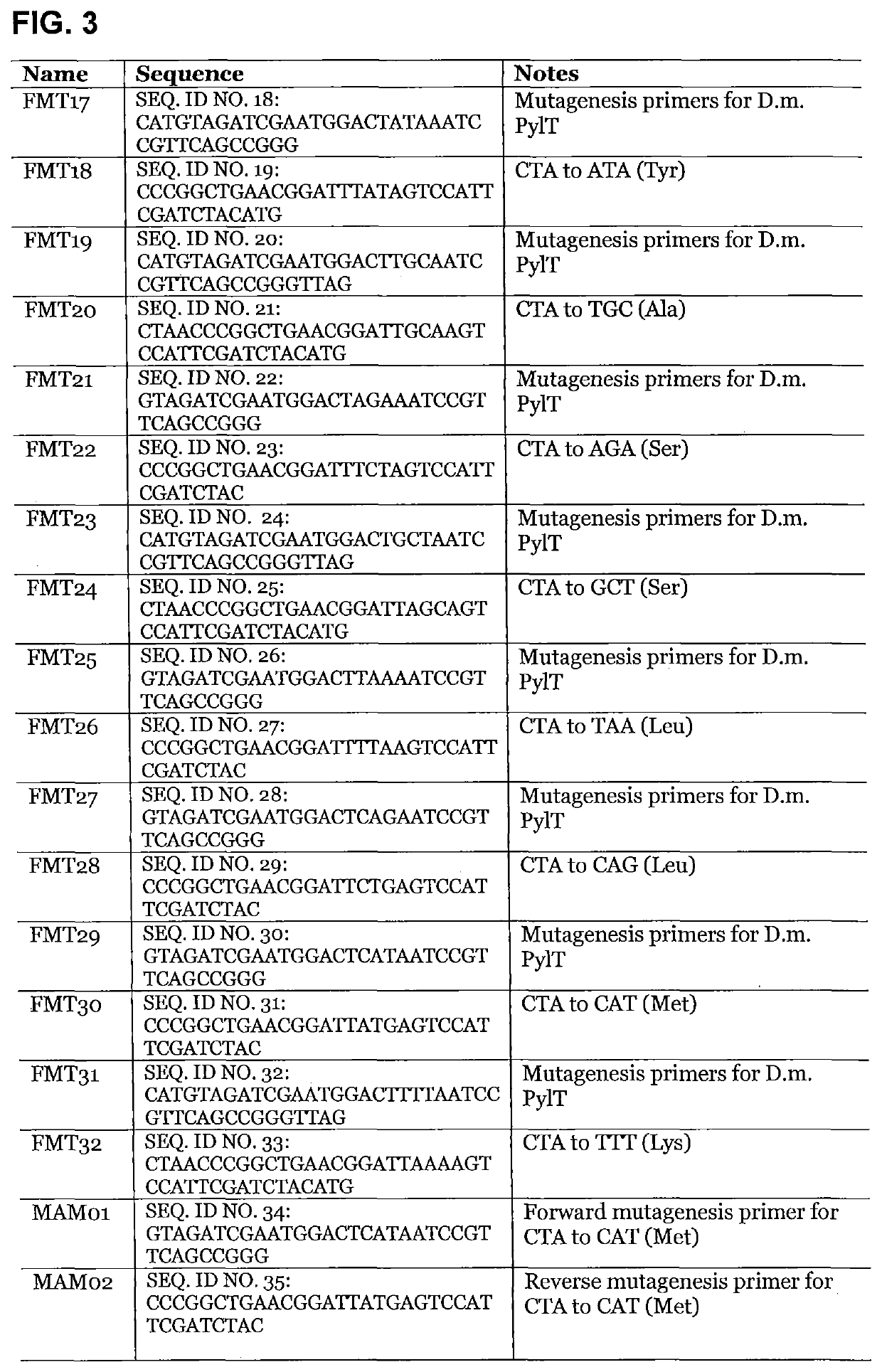Cyclopropene amino acids and methods
a cyclopropene and amino acid technology, applied in the field of site-specific incorporation of bioorthogonal groups, can solve the problems of limited utility of this strategy, laborious extra step in conjugation chemistry, photoactivation in joining tetrazoles to the amino acid of yu et al, etc., to achieve efficient incorporation, less carbon rich, and rapid protein labelling
- Summary
- Abstract
- Description
- Claims
- Application Information
AI Technical Summary
Benefits of technology
Problems solved by technology
Method used
Image
Examples
example 3
ncoding of 3 in Human Cells
[0202]Full-length mCherry-3-GFP-HA was expressed in HEK293 cells carrying the PylRSARNACUA pair and mCherry-TAG-EGFP-HA (a fusion between the mCherry gene and the EGFP gene with a C-terminal HA tag, separated by the amber stop codon (TAG)).18 Full-length protein was detected only in the presence of the 3 (FIG. 8a. Full gels in Supplementary FIG. 11). mCherry-3-EGFP-HA was selectively labelled with 4a, while mCherry-1-EGFP-HA was not labelled (FIG. 8b)18 demonstrating the site-specific incorporation of 3 with the PylRS / tRNACUA pair in human cells.
Example 4—Genetic Encoding of 3 in D. melanogaster
[0203]We demonstrated that 3 can be site specifically incorporated into proteins in D. melanogaster. To achieve this, we used flies containing the PylRS / tRNACUA pair (with the tRNA expressed ubiquitously from a U6 promoter and UAS-PylRS expression directed to ovaries using a nos-vp16-GAL4 driver), and a dual luciferase reporter bearing an amber codon between firefl...
example 5
[0204]
[0205]Boc-protected Tetrazine S6 was synthesized using the procedure reported earlier6. 4M HCl in dioxane (500 μL, 2.0 mmol) was added to a stirring solution of Tetrazine S5 (8 mg, 0.02 mmol) in DCM (500 μL). The reaction was carried out for 2 h at room temperature and subsequently the solvent was removed under reduced pressure to yield primary amine hydrochloride S6 as a pink solid (6 mg, 0.02 mmol, 100%). The compound was directly used in the next step without any further purification.
ii. 4d
[0206]BODIPY FL succinimidyl ester (5 mg, 0.013 mmol, Life technologies) and Hünig's base (50 μl, 2.8 mmol) were added to the solution of Tetrazine-amine S2 (6 mg, 0.02 mmol) in dry DMF (1 mL). The reaction mixture was stirred at room temperature for 16 h. The reaction mixture was diluted with 4 ml of water and the product was purified by semi-preparative reverse phase HPLC using a gradient from 10% to 90% of buffer B in buffer A (buffer A: H2O; bufferB: acetonitr...
example 6
REFERENCES TO EXAMPLE 6
[0228](1) Zhang, J.; Campbell, R. E.; Ting, A. Y.; Tsien, R. Y. Nature Reviews Molecular Cell Biology 2002, 3, 906.[0229](2) Kajihara, D.; Abe, R.; Iijima, I.; Komiyama, C.; Sisido, M.; Hohsaka, T. Nat Methods 2006, 3, 923.[0230](3) Brustad, E. M.; Lemke, E. A.; Schultz, P. G.; Deniz, A. A. J Am Chem Soc 2008, 130, 17664.[0231](4) Nguyen, D. P.; Elliott, T.; Holt, M.; Muir, T. W.; Chin, J. W. J Am Chem Soc 2011, 133, 11418.[0232](5) Wissner, R. F.; Batjargal, S.; Fadzen, C. M.; Petersson, E. J. J Am Chem Soc 2013, 135, 6529.[0233](6) Neumann, H.; Wang, K.; Davis, L.; Garcia-Alai, M.; Chin, J. W. Nature 2010, 464, 441.[0234](7) Wan, W.; Huang, Y.; Wang, Z.; Russell, W. K.; Pai, P. J.; Russell, D. H.; Liu, W. R. Angew Chem Int Ed Engl 2010, 49, 3211.[0235](8) Chatterjee, A.; Sun, S. B.; Furman, J. L.; Xiao, H.; Schultz, P. G. Biochemistry 2013.[0236](9) Wang, K; Sachdeva, A.; Cox, D. J.; Wilt N. W.; Wallace, S.; Mehl, R. A.; Chin, J. W. submitted.[0237](10) Wu, ...
PUM
| Property | Measurement | Unit |
|---|---|---|
| reaction rates | aaaaa | aaaaa |
| mass | aaaaa | aaaaa |
| mass | aaaaa | aaaaa |
Abstract
Description
Claims
Application Information
 Login to View More
Login to View More - R&D
- Intellectual Property
- Life Sciences
- Materials
- Tech Scout
- Unparalleled Data Quality
- Higher Quality Content
- 60% Fewer Hallucinations
Browse by: Latest US Patents, China's latest patents, Technical Efficacy Thesaurus, Application Domain, Technology Topic, Popular Technical Reports.
© 2025 PatSnap. All rights reserved.Legal|Privacy policy|Modern Slavery Act Transparency Statement|Sitemap|About US| Contact US: help@patsnap.com



